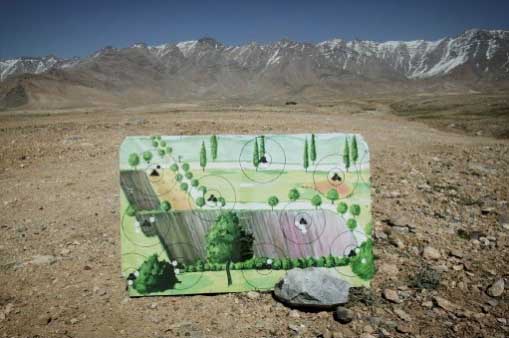Subscribe to ShahidulNews
![]()
Zainul Abedin, S. M. Sultan, Shahabuddin, Manzoor Alam Beg, the list goes on. What a delightful treat. What a rare opportunity for Bangladeshis to see original works of art by these legendary artists all under one roof. Drik and the Prince Claus Fund go back a long way. The Fund has been a long standing patron of Chobi Mela, our festival of photography and Drik is a Network partner of the fund. Both organisations see culture as a catalyst for change. At a time when the world is divided and most western organisations have played safe on controversial issues, the fund has recognised and awarded outspoken artists and has ensured that their voices be heard, through their publications and by supporting and recognising their art. That has been the basis of our solidarity, and Drik has had the honour of participating in many of these projects. The Mondrian Foundation is a new friend. But the Foundation’s attempts to bridge cultural gaps is very much in keeping with Drik’s own ideals. The Netherlands Embassy remains a trusted partner.
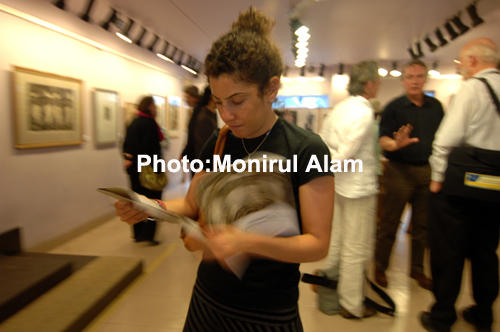 International curators at the exhibition “Contemporary Art of Bangladesh” at the Drik Gallery. The show opened 13 March 2008 and includes original artwork from 1948 till 2008 by some of the legends of Bangladeshi Art. ? Monirul Alam
International curators at the exhibition “Contemporary Art of Bangladesh” at the Drik Gallery. The show opened 13 March 2008 and includes original artwork from 1948 till 2008 by some of the legends of Bangladeshi Art. ? Monirul Alam
This exhibition is very special. Rarely have Bangladeshis had the opportunity of seeing the work of so many outstanding artists under one roof. There are two others at the Asiatic Gallery and at Pathshala. It is a welcome change to see more inclusive exhibitions, where traditional art forms have made way for more contemporary practice. The artists have been very generous with their works, making them available at short notice and without fuss. We value this trust and are grateful for their support. Nisar Hossain admirably steered the process. Combining his passion and his leadership with delicate tact, ensuring that no feathers were ruffled and no feelings hurt. But what a treat they’ve served.
Shahidul Alam
Contemporary Art of Bangladesh
Contemporary art in Bangladesh is a vital activity. Yet its history is short, it started when an art school was set up in Dhaka in 1948 by Zainul Abedin and a few of his colleagues almost immediately after the independence of the Indian sub-continent and creation of the state of Pakistan.
 Zainul Abedin @ Drik Gallery
Zainul Abedin @ Drik Gallery
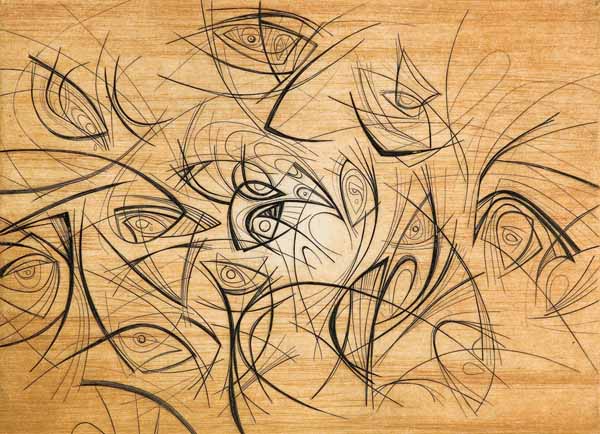 Safiuddin Ahmed @ Drik Gallery
Safiuddin Ahmed @ Drik Gallery
The Government Institute of Arts, like any other liberal, scientific and technical educational institute of this country, was established along old colonial British models. The obvious initial result was development of art forms resembling British academic tradition. But the more talented among the young graduates soon discovered the twentieth century modern art forms and willingly or unconsciously became part of this new tradition.
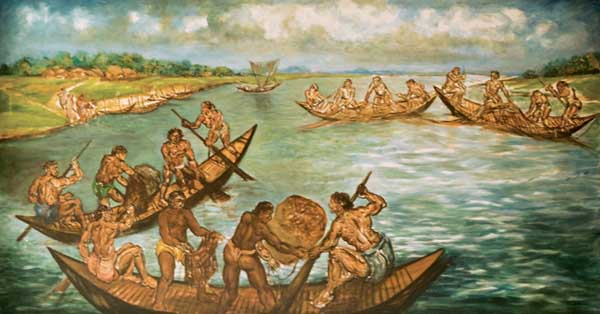 S M. Sultan @ Drik Gallery
S M. Sultan @ Drik Gallery
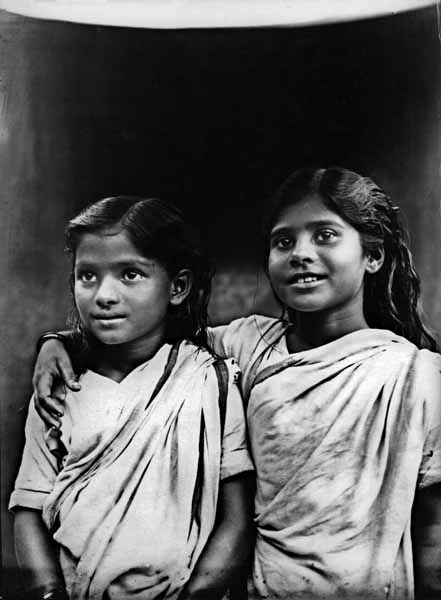 Golam Kasem (Daddy) @ Drik Gallery
Golam Kasem (Daddy) @ Drik Gallery
The artists in Bangladesh could have searched for inspiration in the very rich sculptural tradition of the country which thrived here of many centuries and whose collections are not at all insignificant. It is known that Bengal also has some heritage of drawing, painting and woodcut print making. This tradition is said to date back to the 8th century (Pala dynasty) and continued in some form or other till the 19th century. The Bengal Pata painting and the old (Ramanaya) rolls constitute the painting heritage of Bangladesh. But unfortunately, few examples of such art survive till today and few if any of the modern young artists of Bangladesh have seen them in original or even as good reproduction. For a few senior artists of Bangladesh, Jamini Roy has been a source of inspiration, and through him they have tried to search their own identity and establish a contact with the Bengal folk painting tradition. The revivalist movement of Abanindranath Tagore which has been termed by some as a partial and detour-search for tradition, has never been seriously considered by Bangladeshi artists. Neither the old Indian nor Islamic art had a significant influence upon the contemporary artists of Bangladesh. Only recently some young painters are exploring the possibility of adapting older Indian art techniques and forms.
 Abir Abdullah @ Pathshala
Abir Abdullah @ Pathshala
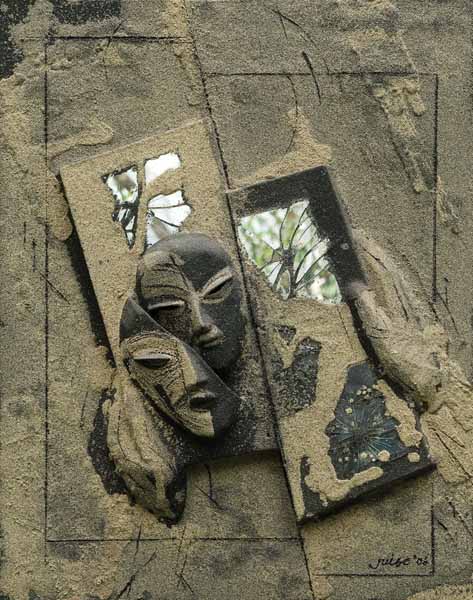
Saidul Huque Juise @ Asiatic Gallery
The contemporary art of Bangladesh is thus based on the models of twentieth century Western art rather than anything else. Modern art has now attained universality with direct or indirect influence all over the world. The Bengali artist work within that great paradigm and as in any paradigm, so it is also in art there is a great scope for local variation and for development of original schools and of course, of individual style. The art scene in Bangladesh is no exception. The modern artist in Bangladesh has used the styles, techniques and temperament of Western art to express himself, his feelings, his emotion, his environment and his society, Sometimes, as has been noted earlier, a few have also tried the traditional-local and Oriental style, techniques and approaches as alternatives to the Western model. Sometimes there has also been a successful blending of the two.
Professor Nazrul Islam
Category: culture
she had a dream…
Rahnuma Ahmed
“A lion is stronger than a man, but it does not enable him to dominate the human race. You have neglected the duty you owe to yourselves and you have lost your natural rights by shutting your eyes to your own interests….”
— Begum Rokeya, Sultana’s Dream (1908)
New York, 1906
Clara Lemlich, a young Jewish woman, joined a group of shirtwaist makers. They wanted to form a union, but didn’t know how. Six young women, six young men and Clara formed Local 25. In those days, the ILGWU (International Ladies Garment Workers Union) was small. Most of its members were male cloakmakers.
Although Clara was determined to be a “good girl,” two days later she was talking union. The oppressive conditions at work made her angry. The forewoman would follow the girls to the toilet. She would needle them to hurry. New girls would be cheated, their pay was always less than agreed upon. The girls would be fined for all sorts of things. They were charged for electricity, needles, and thread. “Mistakes” would be made in pay envelopes, they were difficult to get fixed. The clock was fixed so that lunch hour was twenty minutes short. Or, it would be set back an hour. Not knowing, they would work the extra hour. Unpaid (Meredith Tax, “The Uprising of the Thirty Thousand”).
Clara took part in her first strike in 1907. At one of the union meetings, strikers argued about “pure-and-simple-trade-unionism.” Clara asked one of them what that meant. They went for a walk. Her first lesson in Marxism took place during that forty block long walk. “He started with a bottle of milk?how it was made, who made the money from it at every stage of its production. Not only did the boss take the profits, he said, but not a drop of milk did you drink unless he allowed you to. It was funny, you know, because I’d been saying things like that to the girls before. But now I understood it better and I began to use it more often?only with shirtwaists.” (Paula Scheier, “Clara Lemlich Shavelson”).
In 1908, the first Women’s Day was initiated by socialist women in the United States. Large demonstrations were held.
In 1909, a Women’s Day rally was held in Manhattan. It was attended by two thousand people. The same year, women garment workers staged a general strike. Known as the Uprising of the Thirty Thousand (or Twenty Thousand, depending on the source), the shirtwaist makers struck for thirteen weeks. The weeks were cold and wintry. They demanded better pay, better working conditions.
Bangladesh, 2008
Things are better now, says Moshrefa Mishu, president of the Garments Sromik Oikko Forum (Shomaj Chetona, 1 January 2008). Of course, there are still problems. Workers wages are not paid within the first week of the month. Overtime payments are irregular. Festival allowances and festival leave is not forthcoming unless the girls take to the streets. The minimum wage (1,662.50 taka ?USD 24) is not paid. There is no earned leave. No weekly holidays. Girls do not get maternity leave. If they become pregnant, they get sacked. Appointment letters are not issued. No identity cards are given. They do not get government holidays . For unknown reasons, the eight hour work day, the result of the 1876 May Day movement, and other international movements organised by workers, is not followed in the garment factories. Safety standards in most factories, many of them located in residential areas as opposed to industrial ones, are horribly lacking. These factories, says Mishu, are “death traps.” These traps have killed five hundred workers. Electric short-circuits have led to fires, workers fleeing to save their lives have been trampled to death, locked exits have remained locked even during accidents, or poorly-built buildings have collapsed burying workers underneath the rubble. Mishu spoke of the collapsed Spectrum garment building in Savar, of factory workers in Tejgaon, and of KPS factory workers in Chittagong.
Things are a bit better now, says Mishu, who has been organising workers, and fighting for their rights for the last thirteen years. It was far worse in the beginning. Girls would be worked to their bones. They would work the whole night, but would not get their night bills. Nor would they be paid their overtime bills. Often, not even their basic salaries. There would be a lot of dilly-dallying over wages, aj na kal, this would go on for 2-3-4-5 months. And then, one fine morning the girls would come and and find that the owners had packed up and left. In the middle of the night. No wages, no overtime, nothing in exchange for many months of hard labour. Having a trade union to protect their rights was unheard of. Not only was there no maternity leave, if a girl’s pregnancy was `discovered,’ she would immediately lose her job. She would be forced to leave, penniless. Physical assaults, beatings, threats of acid attack, other forms of intimidation were common. Owners do not regard workers as their colleagues or co-workers, but as slaves. As their servants However, Mishu adds, things have changed. Not big changes. Tiny ones. (Sromik Awaz, 12 January 2008).
She goes on, I have seen many marriages break up. The factories had this outrageous attendance card system. It said, work hours are from 7 am to 5 pm. But, in practice, women worked till midnight. Or, till one in the morning. Why or how it is allowed to happen, I do not know, said Mishu. The 1965 law, the Factory Law says women workers work hours can only be from 7 in the morning to 8 at night. How that can be so blissfully violated in the case of garment factory workers, I do not know. Of course I understand, if there is a shipment yes, but surely there aren’t shipments the whole year round.
Yes, I was talking about work hours, said Mishu, when girls returned home late, of course, they would be returning from work but since the attendance card said work hours were from 7 to 5, husbands would be suspicious. I know of husbands who would beat their wives, who would drag her by the hair, yell abuses, “Where have you been, you whore?” And also, in our country, it is not safe for women to be out so late at night. Rapes, gang rapes, these happen. They still do. Inside the factory too, there is a lot of sexual harassment. There are other problems, there are no colonies close to the factories where the girls can live. They come to Dhaka city in search of work, leaving behind their families in villages, in townships. They live here in a mess, many to a room, or they take in a sub-let room. They can pay the rent, or the local shopkeeper for food items, rice, salt, oil, on getting their wages. If they can’t pay, they are harassed by the landlord, or by the shopkeeper. I know of girls who have been turned out of their rooms by the landlord, sometimes in the middle of the night. Because they could not pay their rent. I have seen girls in Adabor (Mohammodpur), I have seen them take refuge in front of Shaymoli cinema hall, in the verandas of local mosques, and yes, even beneath a tree. And, as you know, girls working in garment factories are very young, as young as 16. The oldest girls are in their early to mid-twenties.
Mishu said, the Emergency has affected the garment workers movement adversely. The May 2006 movement arose over piece rate payments. Payments were very low at the Apex factory. Workers protested, the police opened fire. Shohag, a young worker, was killed. The movement spread like wildfire, in Gazipur and beyond. It spread to Savar, to Ashulia. It erupted later again, in October. We achieved some, said Mishu, our demand for minimum wages, for setting up of a wage board. We also lost. The wage board would include representatives from both owners and workers. But both sets of representatives were to be selected by the owners! Eleven organisations had demanded a minimum wage of three thousand taka. But we were betrayed. Minimum wage was fixed at 1,162.50. But even that is not paid. Of course, we haven’t given up our demand for a minimum wage of three thousand taka. It is ridiculous to expect that workers can live, they can reproduce their labour power, at such low income levels.
The Emergency has adversely affected the garment workers movement. It has made things much worse. Before, because of one movement after the other, there was some hope. The factory owners had nearly agreed to trade unions. I don’t know what the ILO (International Labour Organisation) office is doing sitting here in Dhaka, I am sure they know that trade union activities are banned. That workers do not have basic democratic rights. As a result of the Emergency, we cannot put any pressure on the owners to follow the 2006 tripartite agreement. We cannot pressurise the government either. The owners are benefiting from the Emergency. They are sacking workers, they are implicating both workers and leaders in false cases. There are 19 such false cases against me in Gazipur, and 7 in Ashulia. Working people are increasingly getting very angry. Spontaneous movements keep bursting out in different factories. Whenever any protest takes place, you get to hear another round of conspiracy theories. Either the workers are conspiring. Or their leaders are conspiring. Or, it is an international conspiracy. Issues of social justice in the sector that owns three-quarters of the nation’s foreign exchange earnings, are sidelined.
As far as garment workers are concerned, this government is no different from other governments, said Mishu. It looks upon us as the enemy, as conspirators. It instructs the police to fire bullets at us. Things far worse happen to us. The Emergency has taken away our rights. It has increased the power of the owners over the workers. Our movement is part of the larger movement for democracy, not the state-sponsored one, but the people’s one. The real one. And of course, we wish to link up to other movements that oppress people.
Postscript: A hundred years ago, Sultana had a dream. The lion is bigger and stronger than a man. Just like men who are [generally] bigger and stronger than women. One can invent similar parallels. Like factory owners, who are richer than workers, and have state backing unlike workers. Other parallels also come to mind.
But in Sultana’s Dream there is a twist. Those who are stronger, and more powerful eventually lose. They are outwitted by their captives, who dreamt of freedom and emancipation.
First published in New Age 8th March 2008
A Beginner's Guide to Democracy
Subscribe to ShahidulNews
 |
I don’t often get brainwaves. But there was something about David Miliband?s interview, shown on a private TV channel, that inspired me. I don’t often watch TV either. It was just fate, I guess.
To be honest, it wasn’t only Miliband, the UK Secretary of State for Foreign and Commonwealth Affairs. There have been others. From Britain. From the US. From Australia. From Canada, Germany, the European Union. Some have been visiting dignitaries. Others were diplomats, some of them still posted here. They have given us a steady stream of advice. Some of it was sought, much of it volunteered.
On what to do. How to do. The practical steps involved. The people required. The mechanisms needed. The institutions that must be in place. The values to inculcate.
As a recipient of this sudden surge of Western interest in Bangladesh, a poor, hapless nation, led often enough by wretched, self-serving leaders, as a recipient of endless lectures on democracy, often embellished by locomotive metaphors (‘democracy derailed,’ ‘getting democracy back on track’), I have been at a total loss. So much is being expected of us. What are we to do? And, being part of the derailed ‘us’, what am I to do?
It was Miliband who showed me the way. I knew what I had to do before the interview was over. The relationship between Bangladesh and Britain should be a two way street. We should not only take, we should also give. It should be a modern relationship, as befits a modern world. We should be partners, that’s what he had said.
The mind works in strange ways. Suddenly I remembered Mohammod, a Palestinian friend of mine, from my Sussex days. The three of us, the third being my American flatmate, had been chatting in the kitchen. He had been invited for dinner. “You western people, you are People of the Book,” he had said. “How to cook, how to garden, how to mow the lawn, how to take pictures. For everything, you people have a book. You follow the instructions 1, 2, 3 of your little book.” His laughter had been irresistible. We had joined in. I myself less grudgingly.
Write a How To Do on Democracy? Or A Beginners Guide to Democracy? But why on earth? Why me, and for whom? Dare I?
I got hold of a CD copy of the interview, I transcribed it. I read the transcript several times. It’s not a lengthy interview, only twenty minutes or so, but of course, it’s quality not quantity that matters. It’s a question of having the right attitude, of having a positive frame of mind. I quickly marked out Miliband’s check list for Bangladesh: (i) full, free and fair elections this year (ii) buttressing institutions of a strong civil society (iii) an independent judiciary which treats all cases on merit without fear or favor (iv) a strong media that asks tough questions, and also (v) strong systems of education, health and local government, since the latter are important supports to the formal institutions of democracy.
Miliband was not asked tough questions. The interviewer was not a recognised journalist. Knowing English seemed to be more important. Being able to read questions off the cue card seemed to be more important. I don’t know how these things work, but the end result was there for all to see. No ruffles, no stress, no strain. No curiosity. Just sheer complicity. In the path to democracy project, a project in which Bangladesh is the eager learner, and Britain, as represented by its Foreign Secretary, has all the answers. Tempered, of course, with the appropriate dash of modesty (‘I have been in Bangladesh for six hours, I have to be careful about pretending to be an expert on Bangladesh’).
Complicity doesn’t just happen. It is an act of creation, and there is no reason to assume that a lot of effort isn’t involved. What were the ground rules at work in Miliband’s TV interview? My guesses are made on the basis of the effect that was achieved. That made it so tidy.
Rule 1: Take everything at face value. When Miliband says, British citizens of Bangladeshi origin “look very closely at developments in Bangladesh. They have family here, they worry about economic, social, political issues,” do not ask whether they are similarly concerned at developments in Britain. At the increasing loss of liberties. At Islamophobia. Do not ask how they are contributing to the movement for democracy in post 9/11 Britain, a Britain decidedly less democratic than it was earlier. Don’t take up the “two-way process” seriously.
Rule 2: Ask self-evident questions, these help to elicit self-evident answers. “What are your views on the road to democracy for Bangladesh? Or where are we on the roadmap for democracy?”, this is a good instance. It helped the Honorable Foreign Secretary come up with the checklist I mentioned above. Do not engage with his answers. When he speaks of Britain and Bangladesh’s “shared interests,” do not ask him whose interests he’s talking about. Whether that of the Labour government, or that of the British people. Do not ask him whether the Blair, or the present Brown, government genuinely represents the interests of the British people. Do not breathe a word about the million strong anti-war demonstration held in London several years ago.
When Miliband speaks of trade relations between Britain and Bangladesh, of Britain as an investor, do not raise the issue of Asia Energy (re-named Global Coal Management). Do not bring up the issue of Phulbari, of the strong and vibrant people’s movement against Asia Energy, against open pit mining. Do not quote the British High Commissioner’s statement, “Many of you will be aware of UK-based Asia Energy Corporation?s contract to mine coal at Phulbari, but may not know that other British investments in coal and power generation are also waiting for the green signal from the Government here. These new projects, when implemented, would double the value of the UK?s cumulative investment in Bangladesh.” Nor this one, “Yes, I will continue to lobby for new British investments particularly in the energy sectors in Bangladesh” (same speech).
When Miliband speaks of his passion for the environment, do not ask him why energy corporations do not calculate carbon costs when they declare their assets. When he says, “Don’t repeat our mistakes,” do not ask him whether that impacts on Asia Energy’s push for open pit mining. (Do not mention conflict of interest between the government and people of Bangladesh. Especially avoid mention of Dr. M Tamim, the Advisor’s Special Assistant for Power and Energy Ministry and his private consultancy).
Rule 3: Do not mention instances to the contrary. When Miliband says, “So the road to democracy first of all, needs to have full, free and fair elections,” ” the elections are seen to be a credible expression of the will of the Bangladeshi people,” “help make sure that democratic voices are heard through the ballot box not outside it,” do not raise questions about the overthrow of a popularly elected leader in Iran in 1953. Do not raise any questions about Hamas. Do not ask why 36 of the 39 Hamas Palestinian Legislative Council members that the Israelis abducted in 2006, are still detained. Why some of them haven’t even been charged. Do not say the un-sayable, that more Palestinian legislators are in prison than legislators from all the other parliaments in the rest of the world put together. Do not ask tough questions.
When Miliband speaks of the necessity of an “independent judiciary which treats all cases on merit without fear or favor, a strong media that asks tough questions,” do not bring up the Hutton report (2004) on the BBC, regarded by several national newspapers as an “establishment whitewash.” The report was considered to be uncritical of the government. Don’t mention former Chilean dictator General Augusto Pinochet’s name either, and why Britain had refused to extradite him.
Rule 4: Treat history as irrelevant, trivialise it. Use it as a decorative word, as having no content. You can utter the words, Bangladesh and the United Kingdom share a very strong historical linkage, but steer clear of what that “linkage” involves — British colonialism, exploitation, historical struggles, injustices, movement for freedom.
Rule 5: Treat what is happening in the world as irrelevant. Do not talk of the blockade of Gaza, of Israeli settlements, of the West’s refusal to talk to Hamas, Israel’s apartheid practices, its land thefts, slaughter of Palestinian children. Of the slow genocide that it is inflicting on defenceless civilians, bulldozing houses, torture and assassinations. Of voices of protest. Of Rachel Corrie. Do not talk of Iraq. Or Afghanistan. Do not mention that a recent report cites as many as 6.6 million post-invasion excess deaths in Occupied Afghanistan as of February 2008. That post-invasion excess deaths in the Iraq War are now about 1.5-2 million.
Absolutely do not mention that UK playwright Harold Pinter, in his 2005 Nobel Prize Acceptance Speech urged the arraignment of Bush and Blair before the International Criminal Court for war crimes. He had said, “How many people do you have to kill before you qualify to be described as a mass murderer and a war criminal?
Postscript:
In a recent address before an audience at Oxford University, in honour of Myanmar opposition leader Aung San Suu Kyi, David Miliband has said, “the goal of spreading democracy should be a great progressive project.” He refused to categorically rule out military action against Iran.
The road to democracy in Bangladesh as chalked out by her western partners seems to be signposted with the messages: Take everything at face value. Do not ask tough questions.
First published in The New Age on 4th March 2008
Bangladesh 1971
Subscribe to ShahidulNews
![]()
They had risked all to hold on to this moment in history. The scarred negatives, hidden from the military, wrapped in old cloth, buried underground, also bore the wounds of war. These photographers were the only soldiers who preserved tangible memories, a contested memory that politicians fight over, in their battle for supremacy. These faded images, war weary, bloodied in battle, provide the only record of what was witnessed. Nearly four decades later, they speak.
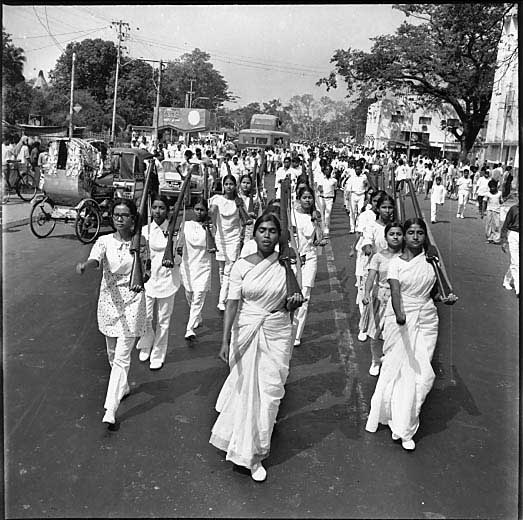
Women marching in the streets of Dhaka. 1971. ? Rashid Talukder/Drik/Majority World
A photographic exhibition and film season that focuses on one of South Asia?s most significant political events: the foundation of Bangladesh as an independent state.
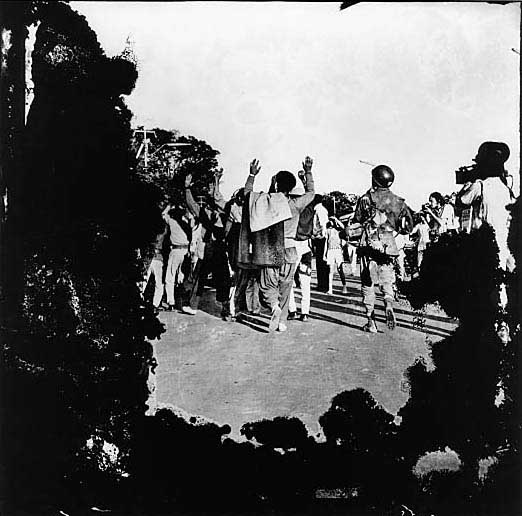 Pakistani soldiers surrendering on the 16th December 1971. ? Aftab Ahmed/Drik/Majority World
Pakistani soldiers surrendering on the 16th December 1971. ? Aftab Ahmed/Drik/Majority World
The Bangladesh war of independence in 1971 was one of the bloodiest conflicts in living memory. In an attempt to crush forces seeking independence for what was then East Pakistan, the West Pakistani military regime unleashed a systematic campaign of violence that resulted in the deaths of thousands of Bangalis. Many of the photographs from the unique collection of the Drik archives will be shown in the UK for the first time.
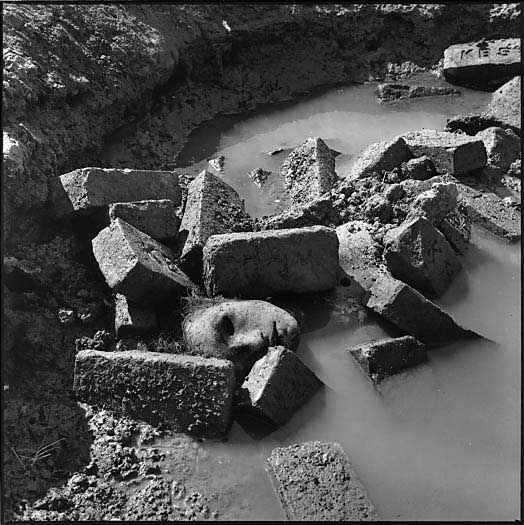 Dismembered head at the Rayerbajar Killing Fields where intellectuals were slaughtered on the 14th December 1971 ? Rashid Talukder/Drik/Majority World
Dismembered head at the Rayerbajar Killing Fields where intellectuals were slaughtered on the 14th December 1971 ? Rashid Talukder/Drik/Majority World
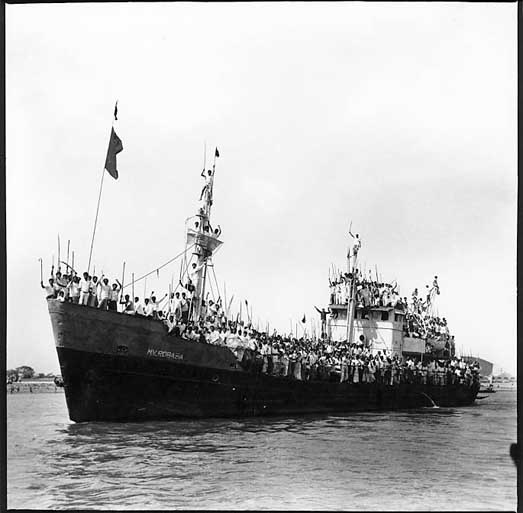 Victorious Mukti Bahini returning home at the end of the war. ? Jalaluddin Haider/Drik/Majority World
Victorious Mukti Bahini returning home at the end of the war. ? Jalaluddin Haider/Drik/Majority World
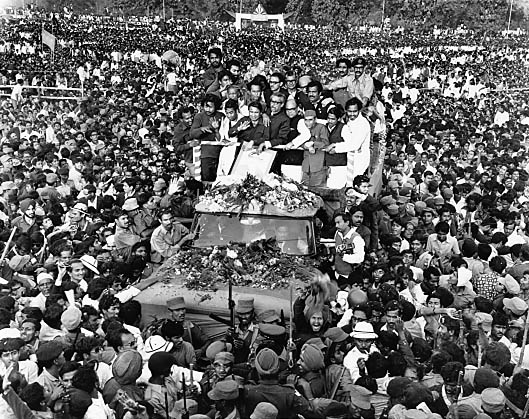 Sheikh Mujibur Rahman on his return to Bangladesh from Pakistan. 10th January 1972 ? Rashid Talukder/Drik/Majority World
Sheikh Mujibur Rahman on his return to Bangladesh from Pakistan. 10th January 1972 ? Rashid Talukder/Drik/Majority World
In 266 days Bangali, hill people and Adivasi resistance fighters and their allies defeated the military forces of Pakistan. The result was the birth of a new nation – Bangladesh – and the dismemberment of Pakistan.
It was only after the 16th of December 1971 when Pakistani troops surrendered in East Pakistan, that Bangladeshis began to realise the scale of the atrocities committed during the previous nine months.
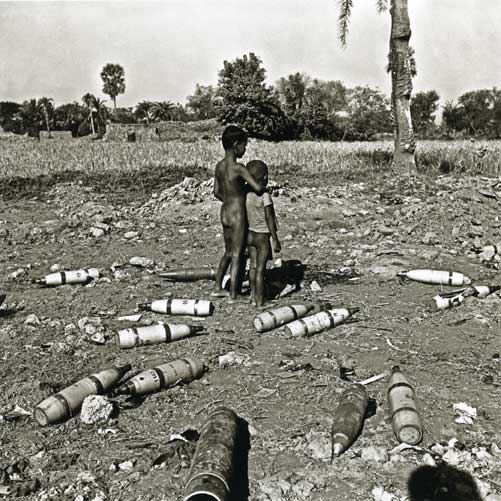 Children amidst shells. ? Abdul Hamid Raihan/Drik/Majority World
Children amidst shells. ? Abdul Hamid Raihan/Drik/Majority World
1971 was a year of national and international crisis in South Asia. The history of Bangladesh is implicitly tied to the partition of India in 1947 and therefore the tragic events of 1971 are linked to Britain?s colonial past. For Bangladesh, ravaged by the war and subsequent political turmoil, it has been a difficult task to reconstruct its own history. It is only during the last few years that this important Bangladeshi photographic history has begun to emerge.
Now decades after the war, Autograph ABP in collaboration with Drik presents a historical photographic overview of Bangladesh 1971 at Rivington Place.
Project Description
A major documentary photographic exhibition of primarily Bangladeshi photographers that focuses on the independence struggle in 1971. The exhibition is produced in partnership with Shahidul Alam, Director of Drik, a media activist and journalist from Bangladesh. This will be the first comprehensive review in the UK of one of the most important conflicts in modern history. It is recognised that over a million people died in 266 days during the struggle for an independent Bangladesh.
UK partner Autograph ABP. Curator Mark Sealy, director of Autograph ABP.
Exhibition open to public April 4th ? 31st May 2008
Press View – Both curators will be available to meet the press 11.30am ? 1pm April 3rd
The exhibition is accompanied by the Bangladesh 1971 Film Season throughout April 2008 in partnership with Rich Mix and The Rainbow Film Society. Please see attached document for full details.
For further information or images, contact Indra Khanna 020 7749 1261 or David A Bailey 020 7749 1264.
Autograph ABP, Rivington Place, London EC2A 3BA.
Notes:
VENUE
Rivington Place
off Rivington Street
London EC2A 3BA
020 7749 1240
April 4th ? 31st May 2008
Open Tuesday – Friday 11am – 6pm
Saturday 12pm – 6pm
Entry is free. Venue is wheelchair accessible.
? Shahidul Alam: Curator, photographer, activist. Gallery Talk (in Bengali) 2pm April 5th
? Mark Sealy: Director of Autograph ABP. Gallery Talk (in English) 6.30pm April 17th
? Many other talks and events to be confirmed
? Bangladesh 1971 Film Season throughout April 2008 in partnership with Rich Mix and The Rainbow Film Society
? Special screening of documentaries and artists? films at Rivington Place to be announced
Photographers included in the exhibition: Abdul Hamid Raihan, Aftab Ahmed, BegArt Collection, Golam Mawla, Jalaluddin Haider, Mohammad Shafi , Naib Uddin Ahmed, Rashid Talukder, Sayeeda Khanom and Bal Krishnan.
—–
press-release-bangladesh-1971.doc
Being Ekushey
Subscribe to ShahidulNews
blogger’s note: The 21st (Ekushey) February 1952, is one of the most significant days in Bangladesh’s history and represents the language movement of Bangladesh. UNESCO has declared 21st February as the International Mother Language Day.
——-
By Rahnuma Ahmed
Words or Deeds?
Apology to Aborigines
“The wrongs were done not through words but through deeds. The rights need to be done in exactly the same way. Much breath is wasted in polemic while peoples lives are twisted and broken out of sight of those who speak it.”
Zubair’s e-mail, published in New Age, Monday Feb 18, 2008 caught my eye.
I had turned the pages of the newspaper, but his words brought back memories of my school years. The infinite number of times I had said “sorry” to my mother only to be faced by sheer incredulity on her part. “Sorry bollei hoe gelo?” (So you say you are sorry and that’s it?).
It would be over little things. Everyday things. I had forgotten to put the milk back into the fridge. I had not locked the front door properly. While crossing her, my foot had accidentally touched hers. “Sorry.” I could not help but utter this little word that the Canadian nuns had taught us. This was the mid-sixties. I was studying at a convent in Chittagong. The sisters were patient. They would repeatedly instruct us, If you make a mistake, if the fault is yours, you must say, “I am sorry.” When I used the word at school, they would smile at me. Their smiles were kind and encouraging.
But things were different at home. My mother would immediately retort, Sorry bollei hoe gelo? I was always at a loss. I never knew what to say. What could I say? What should I say? Should I say, “But ma, this is what I am taught at school.” Or, “You are supposed to say this ma.” Or, much later, when I was in high school in Karachi, devouring Barbara Cartland, and Mills & Boons romances, should I have tried to explain “Ma, this is English etiquette, you have to say it. It doesn’t mean anything.” But I was sure all hell would break loose. I was sure she would pounce on my words and say, “Why say it then?” And of course I would be at a total loss.
Think before you commit a wrong, that is what she would say. “But ma, what if something happens accidentally? I didn’t want to, but it happened, still… what then?” She was quick to remind me, if you had been really mindful you would have been more careful with the glass jug. Then she would go on, “If it does, be ashamed, behave ashamed. Don’t go around, still strutting… And make sure it never happens again.”
The years had passed. I was on my own. I kept making mistakes. I kept mumbling sorry. But I was not able to forget my mother’s words. I felt there was something more to it. But what was it? Manners? Or rather, lack of? That was often implied, that they had more, we had less. I was quite unconvinced. There must be something else. Maybe it has to do with language. I was not sure. Philosophy, ethics? I was not sure. I used to read a lot, but I could not find any answers. I couldn’t forget her words either.
Many more years later, I came across John Austin’s work. In How To Do Things With Words, Austin, a philosopher of language says, language does not only convey information. It is a mode of action. Speaking involves acts: labouring, writing, cooking, cleaning, marrying, marching. And therefore, a theory of language is part of a theory of action. There are two kinds of utterances, constative, and performative (he revised much of this later, but that’s a separate issue). Constative ones are descriptive; they report. They are either true or false. For instance, the jug is made of glass. East Pakistan was part of Pakistan. The history of Aboriginal Australians is one of genocide. Performative ones are different. What is important here is the attitude of the person speaking — her feelings, perceptions, intentions. For instance, take the case of a groom who has uttered “kobul” (I do) at a marriage ceremony, but has not disclosed the fact that he has a wife and two kids. Both marriages are valid in Muslim law, but many would doubt his sincerity and honesty.
Following Austin I could see that when I said “I am sorry”, whether I meant it genuinely or not was more important than uttering the word. My thoughts returned to what ma had said. Was that what she was driving at? At the meaning? Or did her words belong to let’s say, a different moral universe? Hmm, I thought, it’s both yes and no. If something happened accidentally, against my will, then yes. I would have to be remorseful. Sincerely so. What were her exact words? Behave ashamed. But the other half of her lesson, that had been different. Think before you commit a wrong. Think. So that the need to say I’m sorry does not arise. I found Austin very interesting. I hadn’t thought a theorist or a philosopher of language would give importance to the speaker’s intentions, to her feelings. I hadn’t thought what a speaker, or writer, meant by kobul was part of the meaning of kobul. Linguistics no longer seemed boring.
I return to the present. I look at younger mothers who instruct their children to utter the word “sorry.” I remember a young friend who had come with her three year-old. He had spilt food, and she insisted, “Tell aunty you are sorry, tell her you are sorry for spilling the food.”
I feel slightly bemused when I read an article reporting a survey on the use of the word sorry by Britons (“Sorry to say,” BBC News 24). The article tells us that the word originated from the Old English word ‘Sarig’, which meant “distressed, full of sorow.” What had earlier been a hard to use word is now an “over-used figure of speech.” It is “common.” It is a “cheap and convenient way” of excusing inappropriate, anti-social behaviour. According to the survey’s findings, the average person in Britain says sorry often. Two-thirds of the time, they don’t mean it.
I am more convinced than ever. My mother must have meant something very fundamental when she had objected to the word “sorry”.
Getting it wrong?
The ex-law advisor to the current government Barrister Mainul Hossein will be remembered. For his unforgettable statements. One of these was to waiting journalists. Something to this effect, ‘If you exercised self-censorship yourself, we would not have to censor you, would we?’
Not all private TV channels have toed the line. Not all of the time. Recently, Shahidul was interviewed by one of the channels. Before the recording began, he was chatting with members of the crew. Talk soon turned to the emergency, the current economic slump, and to media restrictions. Talk turned to Ekushey TV, to the ban on Ekushey Shomoy, and Ekushey Raat. A member of the recording crew nodded his head and said sympathetically, [The problem was] oder self-censorshipta thikmoto hocchilo na. (They weren’t getting their self-censorship right).
It’s funny. It’s also very telling. We not only need to censor ourselves. We also need to pitch it right. Who does that benefit and how? What does apology do for those who apologise? That’s the question Eva Mackey, a Canadian anthropologist asks of “Sorry Day” ceremonies. These are enacted by local communities in Australia, and seen as part of a “people’s movement.” (“As good as it gets? Apology, Colonialism and White Innocence,” 1999). Her answer is, it accomplishes two things. It foregrounds 200 years of colonial violence, but the acknowledgement is made in order to erase genocidal actions. Simultaneously. Through a few simple words. Like magic. As such, it does a lot for the apologiser. They are able to construct themselves as innocent. The actions themselves are rendered “forgivable.” Before even being spoken, the acts are made forgivable. Not acts that can be punished, or avenged. Not acts that “fall outside the bounds of forgiveness altogether.” She asks, why do Canada and Australia’s attempts at cultural genocide not mean that they be ejected from the United Nations? How can a few simple words do so much? To understand that, says Mackey, we must see apology as a ?speech act.?
Paraphrasing Eva, my question is: what does our self-censorship do for those who rule? It constructs them as innocent. As uninterested in power. Until the playing field has been levelled. Made empty, for them. The only players.
Getting it right
Is the observance of Language Day a speech act? Mouthing words, saying niceties. Only for one day, each year. Thank you Salam, Rafiq, Barkat, Jabbar, Sofiur Rahman, nine year-old Ohiullah…. Thank you for giving us the Language Day. We are sorry you had to die though…
Or is it about re-creating meanings of love, sacrifice and struggle? For languages and their peoples. For the mother-tongues of other peoples of Bangladesh, the paharis and adivasis. Fighting not only for the survival of languages, but the peoples these languages belong to. Fighting for their physical and cultural existence. Fighting for their freedom from encroaching army camps. Fighting against open-pit mines and eco-parks. One foisted on us in the name of national security, the other in the name of development.
Is it about getting self-censorship right? Or getting it wrong. Again. And yet again.
We should not let Ekushey become a “speech act”. We should be Ekushey.
—————————————————————————————
First published on 21st February 2008 in New Age
Freedom
![]()
![]()
Drifting in cage and out again
Hark unknown bird does fly
Shackles of my mind
If my arms could entwine
With them I would thee bind
Rooms it had eight
And doors it had nine
Windows betwixt you find
Up above the glittering hall
Mirrors might make you blind
What fate alas makes bird do thus
Caged bird breaks free to fly
Of bamboo raw the cage I saw
This mind of mine still longs oh so
Lalon Fakir cries as he sees with his eyes
The cage wither and go*
The body, the soul, the self, the universe, Lalon saw freedom not as an entity outside oneself, but as a lived experience. Within yet afar. Ephemeral but tactile. With wings but encaged.
New forms of slavery form new forms of chains. Violence suffered in silence. Ancestral land commandeered. Resistance made illegal.
What mask does freedom now wear? Freedom to profit is the new elixir. Freedom to reach distant markets, to exploit cheap labour. The word that takes us to such dizzying heights leaves the deepest of wounds with its loss. ‘Foreign’ sounding names, ‘wrong’ coloured skin, ‘different’ passports, circumscribe our new freedoms.
Going beyond walls built to occupy territory. Beyond bombs dropped to coerce the unarmed. Beyond cells built to hold the other. Artists paint with colours that don’t exist. Write with words as yet un-invented. Photograph where light is yet to reach. The cage. The door. The wing. The soul. Freedom.
Shahidul Alam
Festival Director
Chobi Mela V
We invite photographers working in the fields of photojournalism, fine art, conceptual or any other field of photography, to interpret the theme “Freedom” in the widest sense possible. Submissions may be made online from 1st March 2008 through to 31st May 2008. Selections will be made by 15th June 2008. Final work must be submitted by 31st July 2008. Festival opens 6th November 2008. Submission guidelines will be available online.
*Translation by Shahidul Alam from “khachar bhitor ochin pakhi” by Lalon Shah.
Masterclass
![]()
![]()
It feels strange to be called a ‘master’ when the ‘students’ are such hugely talented photographers. When it includes the inimitable grandmaster David Burnett in our midst the discomfort is complete.
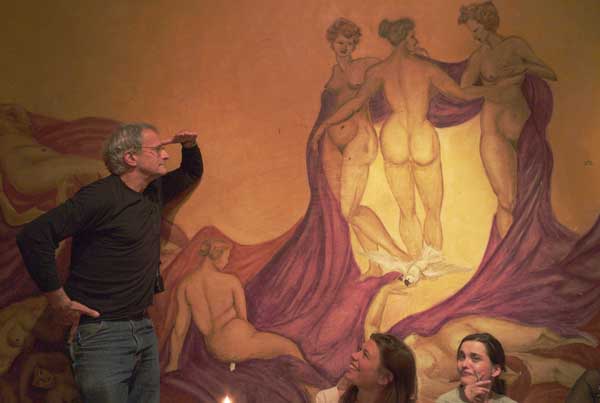 ? Jan Grarup
? Jan Grarup
It was a delight to be in his company again. Though I’ve always enjoyed his images, and we’ve been co-jurors of WPP, this was the first time we’d spent so much time together. The poster for the first ever Chobi Mela in 2000, with his iconic image of the Muktibahini, still hangs on Drik’s corridor. Poor Munem Wasif travelled all the way to Amsterdam only to find his bearded tutor again.
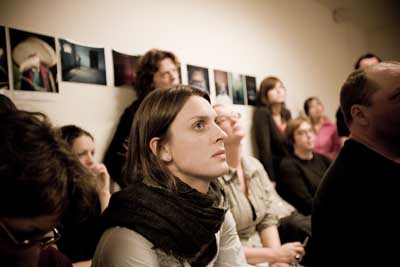
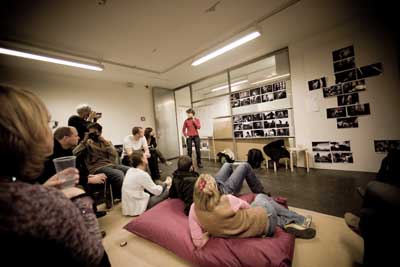
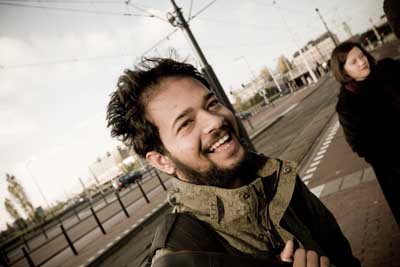
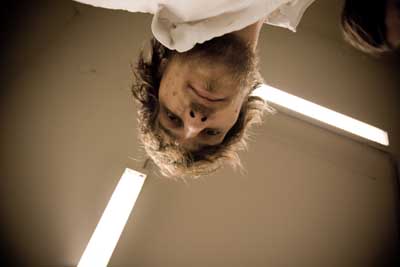
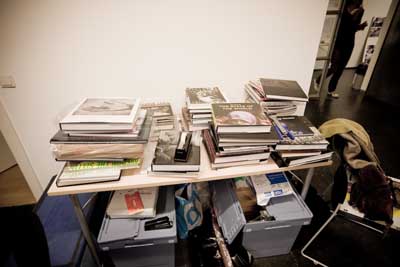
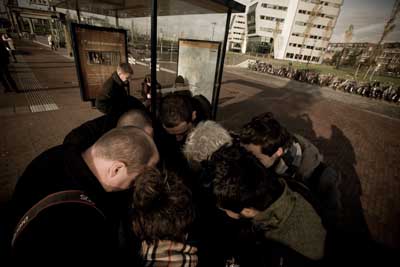
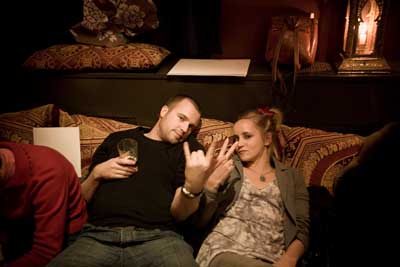 ? Sirio Magnabosco
? Sirio Magnabosco
But the pleasure of such company, the energy within those four walls and the sheer joy of seeing such wonderful images, made up for any qualms I might have had. David’s presentation was humbling. It’s candor, its warmth, the enormous breadth of his work and the unquestionable quality of the photography left me breathless.
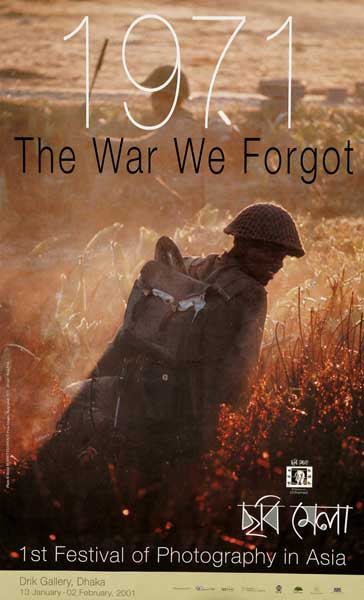 ? David Burnett/Contact Press Images. Design Reza/Drik
? David Burnett/Contact Press Images. Design Reza/Drik
The WPP awards for Christoph, C?dric and Rafel that came in yesterday, was a welcome bonus, but an expected one. This was photography at its finest and despite the vagaries of judging and the imperfections of any selection process, photography such as this must surely rise to the surface.
Oh to be a student again!
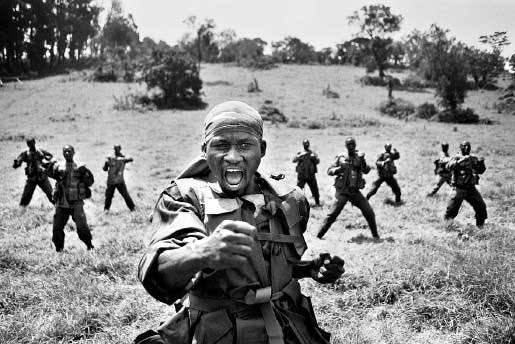
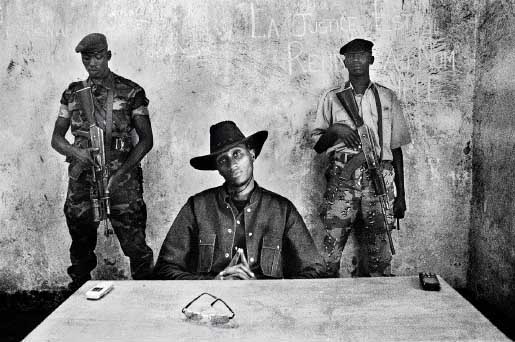
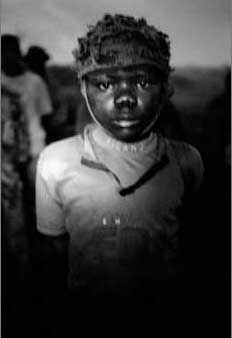

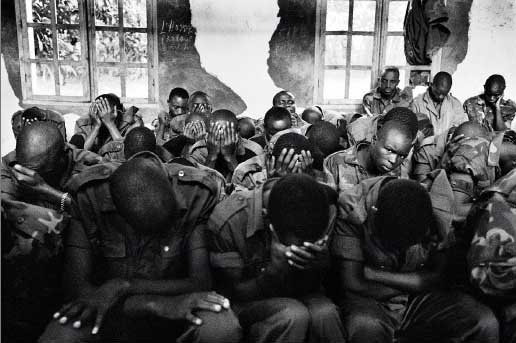
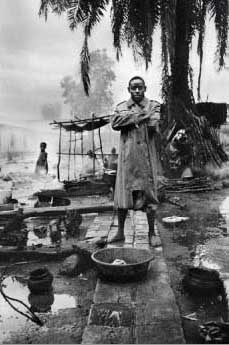
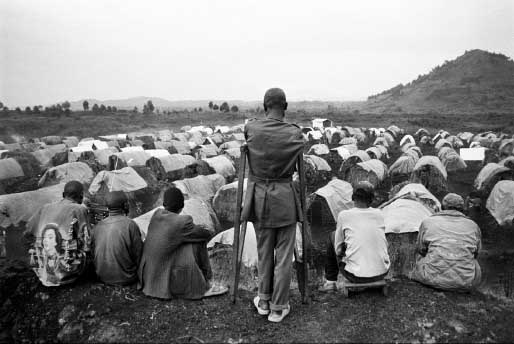
? C?dric Gerbehaye, Belgium, Agence Vu. Congo in Limbo. General News, 3rd Prize Stories. WPP contest 2007
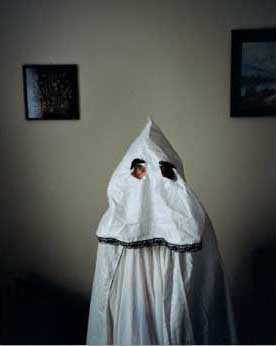
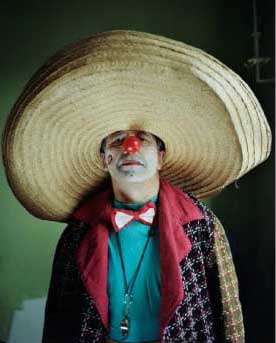
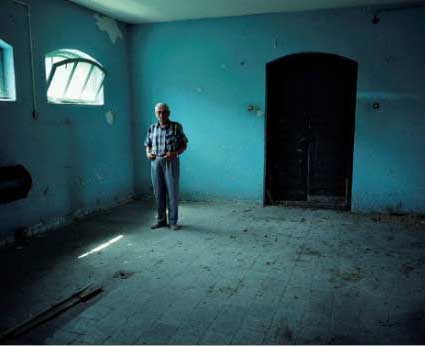
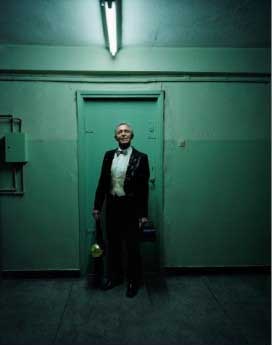

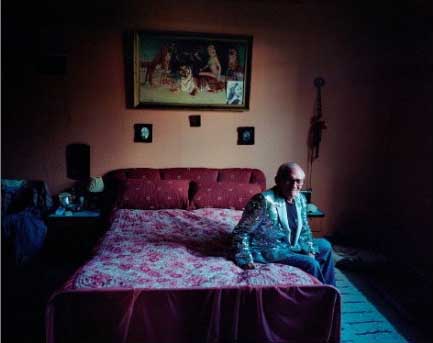
? Rafal Milach, Poland, Anzenberger Agency. Retired circus artists, Poland. Arts and Entertainment, 1st Prize Stories. WPP contest 2007
? Christoph Bangert, Germany, Laif. German Army sniper practice target, Kunduz, Afghanistan, 27 April. General News Singles, Honourable Mention. WPP contest 2007
Joop Swart Masterclass 2007:
Masters:
Shahidul Alam
Susan Bright
David Burnett
Ayperi Ecer
Jan Grarup
Barbara Stauss
Brian Storm
Students:
Ghaith Abdul-Ahad
Olivia Arthur
Christoph Bangert
Kate Brooks
Alexandra Demenkova: Sasha
Agnes Dherbeys
C?dric Gerbehaye
Sirio Magnabosco
Rafal Milach
Munem Wasif
Irina Werning
Xin Zhou
The Rule of Law
![]()
![]()
The flower sellers and the popcorn venders were having a field day. The streets were jammed with traffic diverted from the University. Sales would be good.
 A range of different modes of transport plying Dhaka streets, makes the city roads difficult to negotiate. ? Shahidul Alam/Drik/Majority World
A range of different modes of transport plying Dhaka streets, makes the city roads difficult to negotiate. ? Shahidul Alam/Drik/Majority World
Dhaka University turned into a cantonment,’ said Rahnuma’s text message. I was hurrying to the CMM court in Old Dhaka where the trial of the university teachers was taking place. As I pedaled through the gaps between cars, rickshaws, CNGs (gas run three wheelers) and thalagaris (push carts) I felt glad I was on a bicycle.
 Dhaka University teachers leaving the CMM court in Old Dhaka. ? Shahidul Alam/Drik/Majority World
Dhaka University teachers leaving the CMM court in Old Dhaka. ? Shahidul Alam/Drik/Majority World
Ocassionally biking along the footpath, not strictly legal, I was slowed by the vending stalls and bus ticket counters that had sprung up. Legality was not such a big thing here.
 Bus ticket sellers in New Elephant Road. ? Shahidul Alam/Drik/Majority
Bus ticket sellers in New Elephant Road. ? Shahidul Alam/Drik/Majority
Last night, the guards had caught a guy stealing copper cabling. The thief was a “heroinchi”. They had roughed him up and let him go. Taking the guy to the police wouldn’t have helped. The police would have got richer and the guy would be out stealing again. People take law into their own hands. Bribes are common-place, violence is normalised, nepotism is ripe. Despite the rhetoric at the top, abuse of power is the order of the day. But there is a sub-text. It was wrong of the heroinchi to have stolen the cable, for me to have used the footpath, for the vendors to have taken over public pathways, for the policeman to have taken bribes. Except in my case, there were mitigating circumstances that made all of the other acts less of a crime. The heroinchi had his addiction to blame. The vendors had no other place to go, police salaries were impossible to live on. They might have found other solutions, but they broke the law instead. Unlawful, but not sinister.
I saw other things along the way. The policeman in Gulistan Mor puncturing the tyre of a rickshaw walla caught on a road reserved for cars.
 Policeman with needle used to puncture rickshaw tyres. ? Shahidul Alam/Drik/Majority World
Policeman with needle used to puncture rickshaw tyres. ? Shahidul Alam/Drik/Majority World

Policeman beating up rickshawalla. ? Shahidul Alam/Drik/Majority World
 Policeman controlling traffic at Nawabpur Road. ? Shahidul Alam/Drik/Majority World
Policeman controlling traffic at Nawabpur Road. ? Shahidul Alam/Drik/Majority World
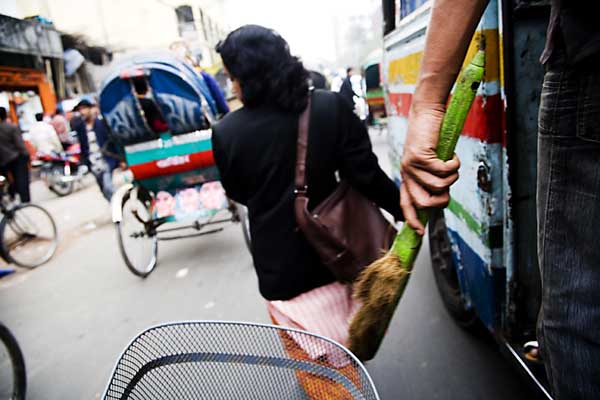 A bus conductor uses a brush handle to beat off nearby rickshaws or other ‘low grade’ traffic. ? Shahidul Alam/Drik/Majority World
A bus conductor uses a brush handle to beat off nearby rickshaws or other ‘low grade’ traffic. ? Shahidul Alam/Drik/Majority World
A policeman on Nawabpur Road, punching a rickshaw walla for some other reason. True, rickshaw wallas don’t always obey the law. But no policeman would have punctured the wheel of a car. No drug baron would ever be roughed up, no hotel owner would ever be shooed off his establishment.



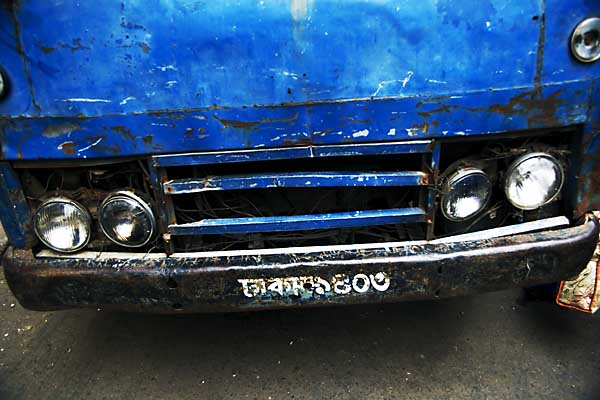 Dilapidated police prison vans outside CMM court. ? Shahidul Alam/Drik/Majority World
Dilapidated police prison vans outside CMM court. ? Shahidul Alam/Drik/Majority World

Military microbus by ‘no parking’ sign near Rapa Plaza in Dhanmondi. ? Shahidul Alam/Drik/Majority World
Few police cars would ever pass a fitness test. The more swank olive green cars, parked illegally, would never be challenged. When power is flouted with such abandon, corruption seeps to all levels. Ordinary people are simply too small to challenge the system. The rule of law must apply to all if it is to work. When the ruling party cannot be challenged, when a military rank gives total authority, when being in power means laws no longer apply, the law of the streets becomes the law of the land.
Much has been said about the students’ protest on campus in August 2007. Little has been said about the cause of the incident. The military cannot occupy a university campus in a free land. It is the duty of any self-respecting student, of any citizen, to challenge such army presence. The arrogance of the soldiers might have aggravated the incident. Their long held belief that they are above the law, surely led to the brutality that followed. But the original crime was one of occupation. And occupation, wherever found, must be resisted.
Why should university students bow to injustice? What values can future citizens uphold having silently accepted the loss of their freedoms? How can a teacher teach knowing he has turned his back to wards being illegally victimised?
 The back door of a prison van waiting outside CMM court. 21st January 2007. ? Shahidul Alam/Drik/Majority World
The back door of a prison van waiting outside CMM court. 21st January 2007. ? Shahidul Alam/Drik/Majority World
To convict and then provide presidential pardon, is an act of self-deification by the government. Those with less clout will continue to languish in jail. A dark and violent jail they should never have entered. If the judiciary be truly independent, then it should call to the docks those who ordered a military occupation of our university. It should bring to trial those who use emergency rule to torture our citizens and muzzle the media. It should penalise those who judge others without subjecting themselves to scrutiny. The rule of law is essential for society to live without fear. For it to apply, it must start at the top.
Pukur (Pare) Churi
![]()
![]()
Their fear of items being stolen, or not being returned, was considered preposterous. When the Honorable Adviser and his excellency the Charge d’Affaires had themselves, guaranteed the safety of Bangladesh’s most prized artefacts, surely the protesters could have no reason to oppose this arrangement. News of the missing crate, and the priceless statues it contained, had been suppressed, but the information leaked out. Could the guarantors please explain?
Mr. Jean Romnicianu, Charges d’Affaires, Ambassade de France ? Dacca, met with Bangladeshi journalists at the French Embassy in the first week of December 2007. In response to questions about the possibility of goods being damaged, stolen, or not being returned, he stated emphatically, “What I am saying is that for at least 30 years, it has never, not once, happened within the framework of an international exhibition. This is an international exhibition with a signed agreement between governments, there is no scope whatsoever of that kind of thing.” “We will take care of the artefacts, until they are returned to the museum. All the insurance and everything is what is called nail to nail,” elaborating that it implied protection from the moment the artefacts left their original position in the museum, to the time it was returned to their original position.
guimet-nail-to-nail.mp3
Today we hear him on television saying “The responsibility of the French Goverment begins from the point where the items are in French cargo.”
“We are not going to put the artefacts at risk by unpacking them,” was also something the Charge d’Affaires had said that day. Today (Dec 24th 2007), the BBC quoted that the remaining crates had all been checked at the airport. So airport officials who have no knowledge of archaeology are permitted to open the crates, while neither members of the expert committee nor the people who are legally required to inspect the artefacts, are allowed to do so. These officials had also signed documents stating they had verified the contents of the crates, which they had obviously not been allowed to do, even though it made the documents presented, technically false.
“The Museee Guimet and our authorities in France have worked rather hard, I must say, even though it resulted in one mistake, in keeping all the controversies outside of the French papers, of the European papers,” the Charge d’Affaires had also said that day. So the cover up was taking place at both the Bangladeshi and the French end. Presumably it continues.
french-statement-on-media-blockage.mp3
(Audio recordings of these statements are available and will be uploaded as soon as they have been digitised)
——–
 The plane that was meant to have taken the artefacts to Paris. ? Munir uz Zaman/DrikNews
The plane that was meant to have taken the artefacts to Paris. ? Munir uz Zaman/DrikNews
 From Pukur Churi (stealing a pond) to Pukur Pare Churi (stealing by a pond). Search party looking for stolen artefacts by the pond at Zia International Airport. ? Munir uz Zaman/DrikNews
From Pukur Churi (stealing a pond) to Pukur Pare Churi (stealing by a pond). Search party looking for stolen artefacts by the pond at Zia International Airport. ? Munir uz Zaman/DrikNews
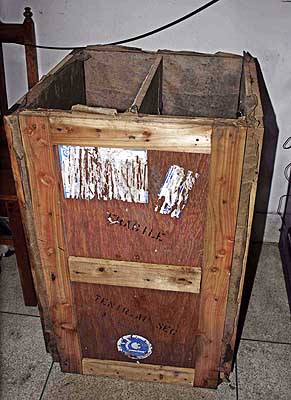 The empty crate. We had been told these were special crates that could not be opened, as they were very special. A 300 year old French company had been especially commissioned to pack the crates. The government and the French embassy decided to show improper documents rather than risk opening these special crates for proper inspection and documentation. Looks like a pretty ordinary crate to me. ? Munir uz Zaman/DrikNews
The empty crate. We had been told these were special crates that could not be opened, as they were very special. A 300 year old French company had been especially commissioned to pack the crates. The government and the French embassy decided to show improper documents rather than risk opening these special crates for proper inspection and documentation. Looks like a pretty ordinary crate to me. ? Munir uz Zaman/DrikNews
 This was a story the state owned BTV had chosen to completely ignore. The rest of the media however, despite government efforts continued to report this important story. Despite the widespread protests and the media attention, the shipment was to go ahead. Both the Cultural Adviser and the French Charge d’Affaires, emphatically promised there was no question of items going missing or not being returned. ? Munir uz Zaman/DrikNews
This was a story the state owned BTV had chosen to completely ignore. The rest of the media however, despite government efforts continued to report this important story. Despite the widespread protests and the media attention, the shipment was to go ahead. Both the Cultural Adviser and the French Charge d’Affaires, emphatically promised there was no question of items going missing or not being returned. ? Munir uz Zaman/DrikNews
b035.mp3 Interview of police officer after discovery of crate (Bangla). Munir uz Zaman/DrikNews
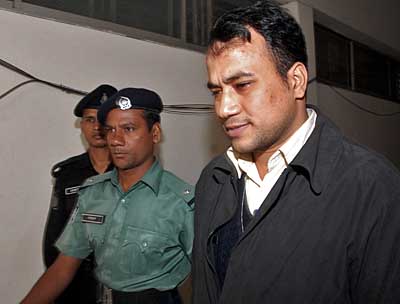 One of the arrested security officers. What of the big fish that masterminded this theft? Or the people who authorised this shipment despite the proven irregularities? ? Munir uz Zaman/DrikNews
One of the arrested security officers. What of the big fish that masterminded this theft? Or the people who authorised this shipment despite the proven irregularities? ? Munir uz Zaman/DrikNews
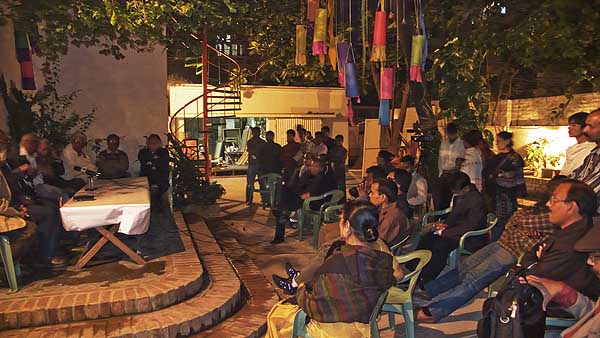 Press conference at Chitrak Gallery, where the incident has been called the most major cultural disaster of the century. ? Shahidul Alam/Drik/Majority World
Press conference at Chitrak Gallery, where the incident has been called the most major cultural disaster of the century. ? Shahidul Alam/Drik/Majority World
——–
It was the letter from Shanika, the girl I had found during the Tsunami in Sri Lanka, that reminded me of how we had forgotten all the other things that were going on. It was now Boxing Day. The Day the Tsunami had struck. Bodies are still being discovered after the Sidr cyclone. Demand for the trial of war criminals has moved off the headlines. Bodies of workers remain buried in the Rangs building rubble. It reminds me of how classed our struggles are. While we had united in protest when our archaeological heritage was being threatened, no such protest had taken place in solidarity with the workers.
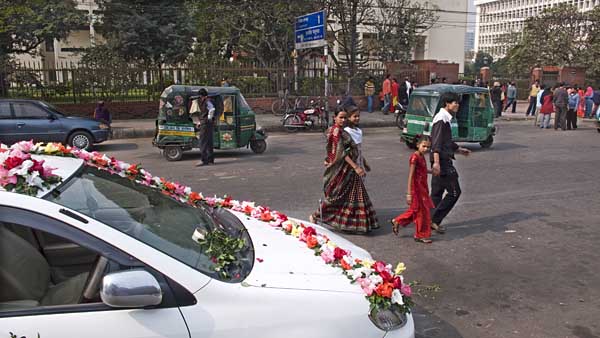 It was Christmas day, and it is the wedding season in Bangladesh. People had gathered outside the musuem, as word had spread that the remaining artefacts were being returned. It was a very different mood, and the local flower shop was using the wide road to decorate a wedding car. ? Shahidul Alam/Drik/Majority World
It was Christmas day, and it is the wedding season in Bangladesh. People had gathered outside the musuem, as word had spread that the remaining artefacts were being returned. It was a very different mood, and the local flower shop was using the wide road to decorate a wedding car. ? Shahidul Alam/Drik/Majority World
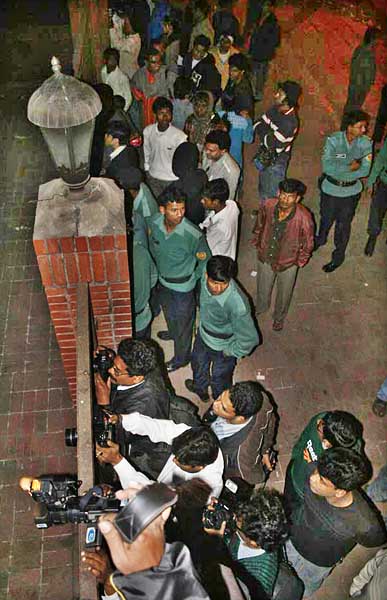 Media professionals outside museum gate watching the return of remaining 12 crates. ? Munir uz Zaman/DrikNews
Media professionals outside museum gate watching the return of remaining 12 crates. ? Munir uz Zaman/DrikNews
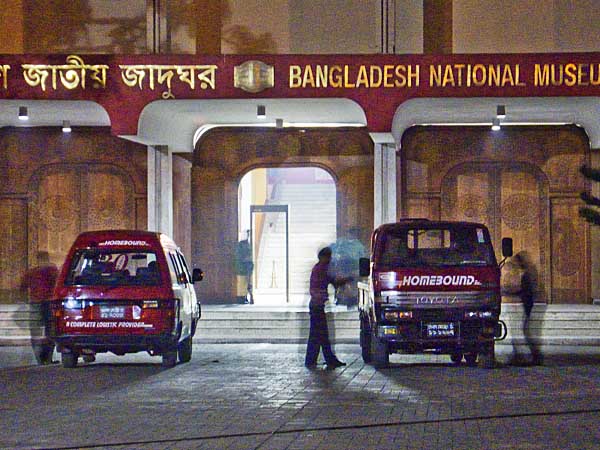 Homebound heading home. The crates are now back in the museum. The demand for reinstating them in their original location continues. ? Shahidul Alam/Drik/Majority World
Homebound heading home. The crates are now back in the museum. The demand for reinstating them in their original location continues. ? Shahidul Alam/Drik/Majority World
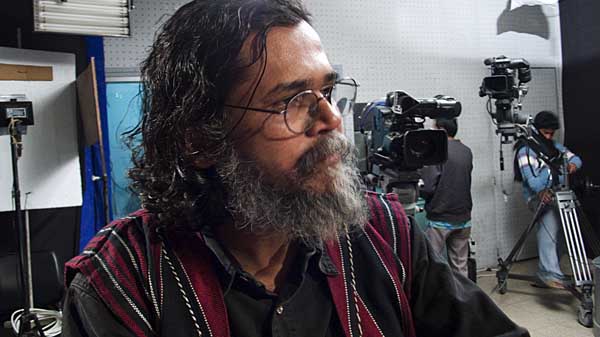 It was the vigilance of Nisar Hossain (teacher at the college of fine arts, affectionately dubbed, ‘Sector Commander’ by fellow campaigners) and his friends that led to many of the irregularities being unearthed. Nisar being interviewed on the ATN channel. ? Shahidul Alam/Drik/Majority World
It was the vigilance of Nisar Hossain (teacher at the college of fine arts, affectionately dubbed, ‘Sector Commander’ by fellow campaigners) and his friends that led to many of the irregularities being unearthed. Nisar being interviewed on the ATN channel. ? Shahidul Alam/Drik/Majority World
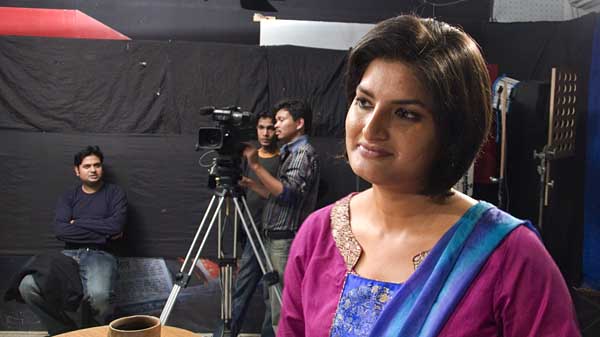 The media played an important role in keeping the issue in the public eye. Munni Saha interviewing Nisar Hossain for a programme in the ATN channel. The discussions included a clear condemnation of the French Charge d’Affaires’ statement blaming the protestors for the theft. The programme will air at 11:00 am Dhaka time on the 26th December 2007. ? Shahidul Alam/Drik/Majority World
The media played an important role in keeping the issue in the public eye. Munni Saha interviewing Nisar Hossain for a programme in the ATN channel. The discussions included a clear condemnation of the French Charge d’Affaires’ statement blaming the protestors for the theft. The programme will air at 11:00 am Dhaka time on the 26th December 2007. ? Shahidul Alam/Drik/Majority World
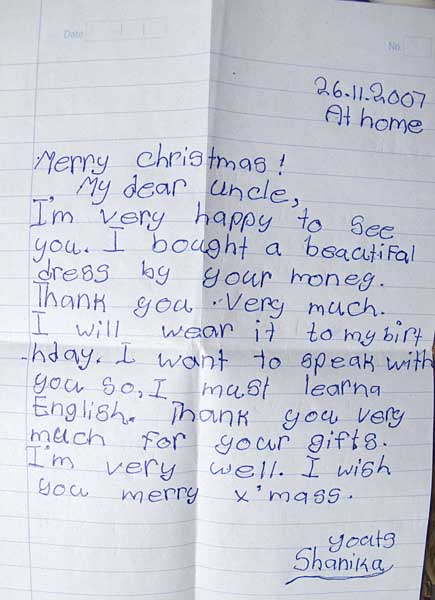 Letter from Shanika, received earlier in the month.
Letter from Shanika, received earlier in the month.
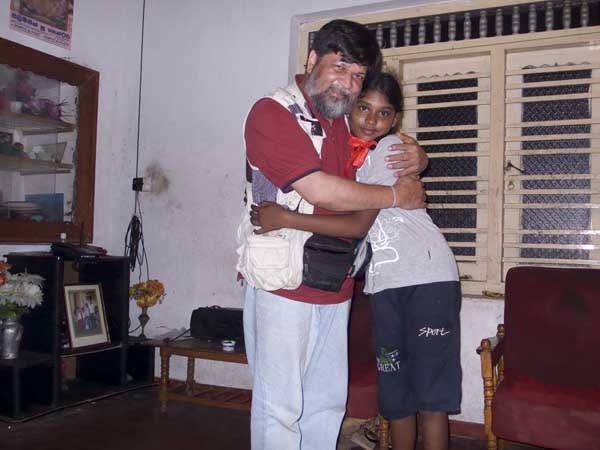 During an assignment for Help The Aged in Sri Lanka last month, I had sneaked a visit to Totagumuwa, in Hikkaduwa to see Shanika. The Tsunami had taken away her mother and her three sisters (including her twin sister). Photo: ? Priantha (Shanika’s dad).
During an assignment for Help The Aged in Sri Lanka last month, I had sneaked a visit to Totagumuwa, in Hikkaduwa to see Shanika. The Tsunami had taken away her mother and her three sisters (including her twin sister). Photo: ? Priantha (Shanika’s dad).
——-
27th December 2007
Sylvie Rebbot, the picture editor of Geo Magazine in France, just sent me this press release last night. It was issued yesterday (the 26th December 2007) by the French Ministry of Culture. While it talks about the theft of the two statues, from Zia International Airport, there is no mention of the 10 crates that are already in Paris at the Guimet Museum.
Press Release by French Ministry of Culture (26th Dec 2007)
261207-cp-expo-musee-guimet.pdf
A Flag Fails to Flutter
![]()
It was a bad day for cows
 Korbani meat being distributed outside National Museum during Eid. 21st December 2007. ? Shahidul Alam/Drik/Majority World
Korbani meat being distributed outside National Museum during Eid. 21st December 2007. ? Shahidul Alam/Drik/Majority World
But the Bangladesh government had a supreme sacrifice in mind. When the most prized of your possessions needed to be sacrificed, and when the gods have changed to western powers, the four-legged creatures simply wouldn't do. The nation's most prized archaeological possessions were therefore bundled away in Homebound chariots to distant museums. The door to heaven's gate might not have opened, but a Schengen visa and perhaps a few trips to Paris for some, had surely been assured.
It was well timed. The Eid holidays meant there would be no newspapers for two days. Most reporters would be away. The streets of Dhaka would be empty. Holidays meant there was no rush. No pesky public to worry about at opening hours. Still one needed to be sure. Bus no Dhaka Jo 11 1767, was on standby with riot police. The police jeep Dhaka Jo 11 4364 followed behind. Then the media that got in the way. With so many Eid events to cover, why had they gathered round the national museum? The sanctity of sacrifice should surely have been respected. Reinforcements in the form of another busload of riot police came in via bus number Dhaka Jo 14 1799.
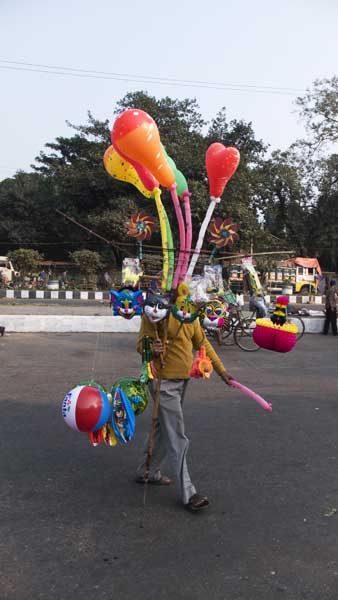 Balloon man outside National Museum. Friday 21st December 2007. ? Shahidul Alam/Drik/Majority World
Balloon man outside National Museum. Friday 21st December 2007. ? Shahidul Alam/Drik/Majority World
 Family out on Eid. Friday 21st December 2007. ? Shahidul Alam/Drik/Majority World
Family out on Eid. Friday 21st December 2007. ? Shahidul Alam/Drik/Majority World
 Aisha outside National Museum. ? Shahidul Alam/Drik/Majority World
Aisha outside National Museum. ? Shahidul Alam/Drik/Majority World
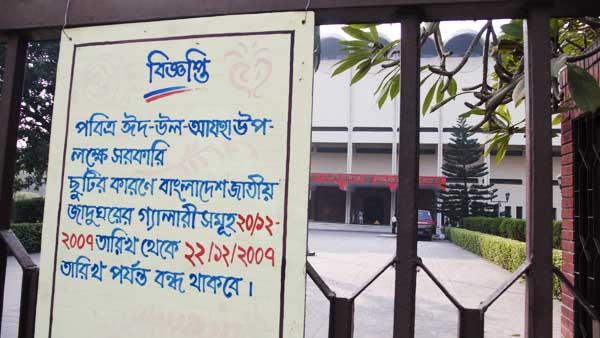 Sign says the museum is closed from the 20th till the 22nd on account of Eid. Friday 21st December 2007. ? Shahidul Alam/Drik/Majority World
Sign says the museum is closed from the 20th till the 22nd on account of Eid. Friday 21st December 2007. ? Shahidul Alam/Drik/Majority World
Aisha had come with her parents to visit the museum. Like many others they were turned away. The museum was closed, at least to the public. The Eid holidays of museum officials had however been cancelled. The shippers were working overtime.
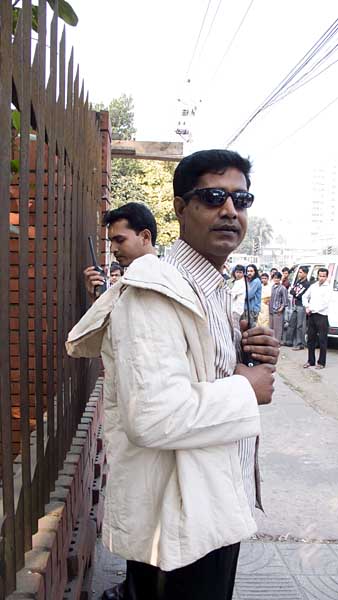
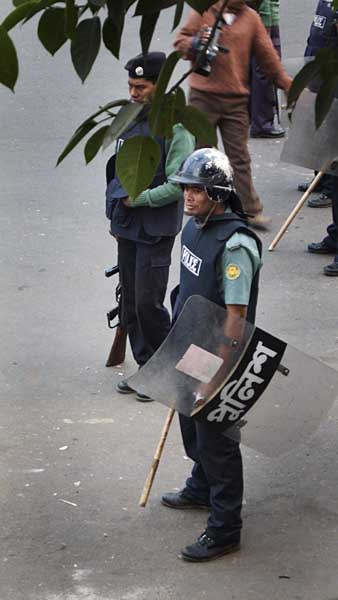
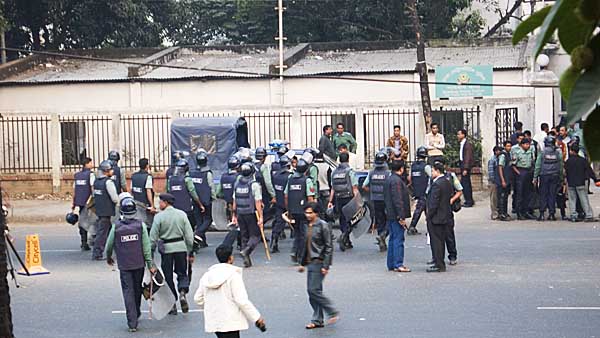 Police returning to station, after staging the 'escape'. ? Shahidul Alam/Drik/Majority World
Police returning to station, after staging the 'escape'. ? Shahidul Alam/Drik/Majority World
Police and plainclothes intelligence officials were present in abundance, their riot gear jarring with the bright new clothes of Dhakaites. Then it took another turn. Spitting and booing had failed to stop the Homebound trucks earlier. This time the protesters changed tack. Chains were put on the gate of the national museum. Visions of the Chipko Resistance
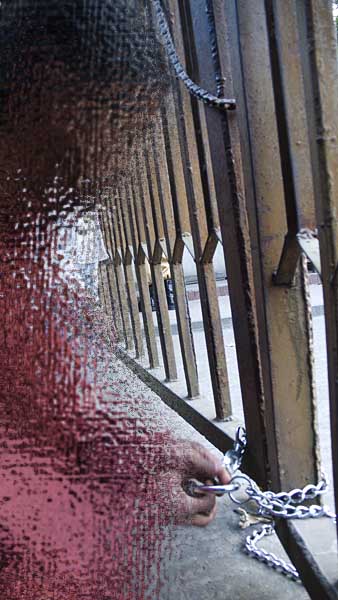 Protester chaining front gate of National Museum. Friday 21st December 2007. ? Shahidul Alam/Drik/Majority World
Protester chaining front gate of National Museum. Friday 21st December 2007. ? Shahidul Alam/Drik/Majority World
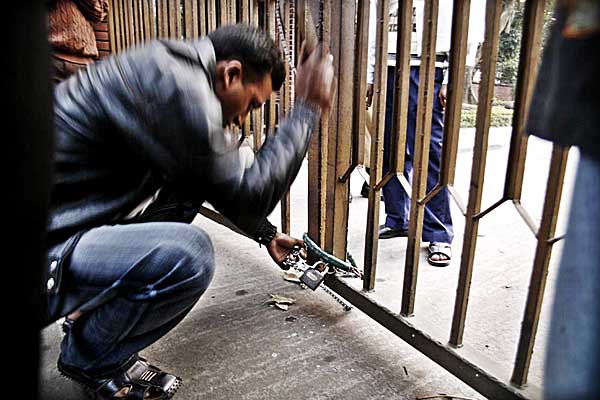 Police breaking padlock at front gate of National Museum. Friday 21st December 2007. ? Gazi Nafis Ahmed/DrikNews
Police breaking padlock at front gate of National Museum. Friday 21st December 2007. ? Gazi Nafis Ahmed/DrikNews
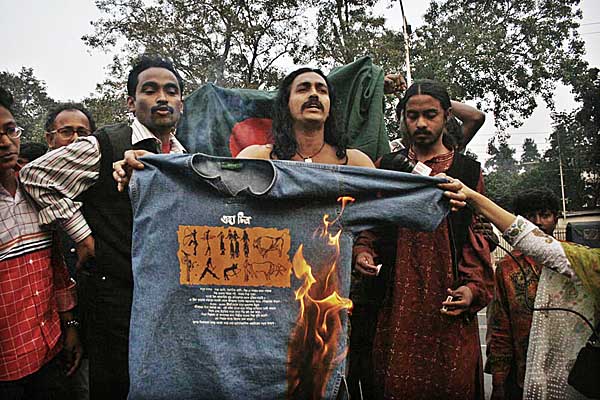 Burning shirt in protest outside National Musuem. Friday 21st December 2007. ? Munir uz Zaman/DrikNews
Burning shirt in protest outside National Musuem. Friday 21st December 2007. ? Munir uz Zaman/DrikNews
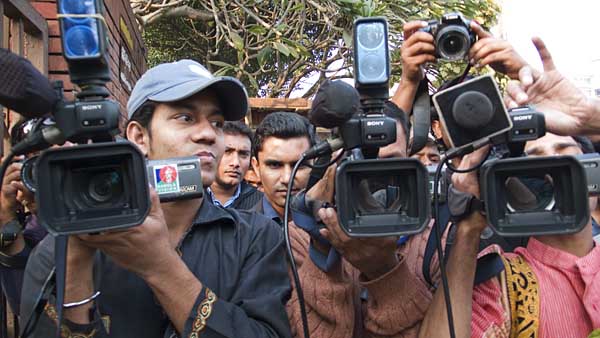 Despite emergency rule and government efforts to bury the story, media continued to give the event full coverage. ? Shahidul Alam/Drik/Majority World
Despite emergency rule and government efforts to bury the story, media continued to give the event full coverage. ? Shahidul Alam/Drik/Majority World
sprang to mind. In place of burglars breaking in, the comic view of government officials breaking their way out of the national museum to escape with museum valuables would have brought laughter in a trirotno drama (popular Bangladeshi sitcom). In the theatre of Bangladeshi governance, it was yet another tragedy.
"The benefits, for both countries, are cultural: it is a win-win situation where France gains a better knowledge of Bangladeshi heritage and Bangladesh gains a better image on the international cultural scene," the French embassy handout had clarified.
The partially demolished Rangs building continues to be a grave for the buried Bangladeshi workers far down the priority chain. Presumably, that is a 'Bangladeshi heritage' the Parisians will not get to see.
The last time round, they had been playing one of my favourite Bhupen Hajarika songs. This time there was no music, and no one was smiling. Even the Bangladeshi flag failed to flutter on this Eid day. Video of trucks carrying artefacs out of museum. ? Shahidul Alam/Drik/Majority World
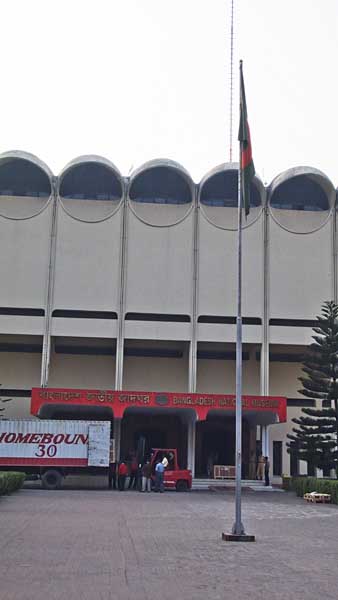 embed> Bangladeshi flag refuses to flutter as prized Bangladeshi objects are taken out of museum. ? Shahidul Alam/Drik/Majority World
embed> Bangladeshi flag refuses to flutter as prized Bangladeshi objects are taken out of museum. ? Shahidul Alam/Drik/Majority World
Video of trucks carrying artefacs out of museum.

